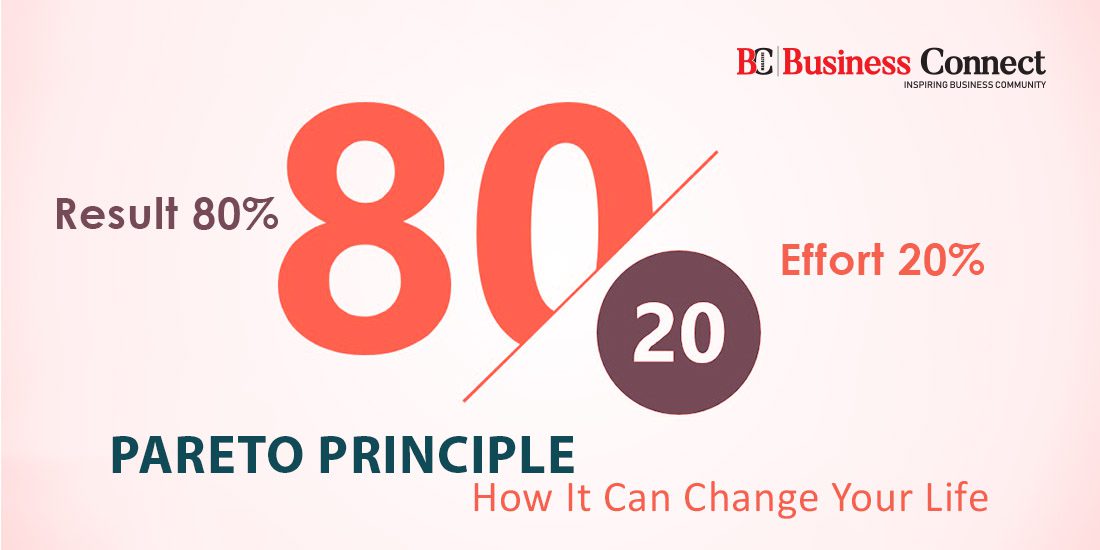PARETO PRINCIPLE: HOW IT CAN CHANGE YOUR LIFE
What if someone tells you that by investing 20 rupees, you can get 80 in return? Most probably, you would go ahead and know more about the scheme. Because the majority of human beings especially, in this modern and busy era, want formula of working less and getting more. Well, the above-mentioned scenario was just a specimen to introduce you to the Pareto Principle.
The Pareto Principle or 80/20 rule is an aphorism that asserts that 80% of the outputs result from 20% of inputs for any given event. But firstly, it is mandatory to know that the 80-20 are not the exact numbers that fit in every category, mostly it will be varied in amount as it is driven by general observation and not by any scientific rule. But the basic meaning of the principle is that majority of your achievements are the result of a minority of the efforts you have put into it.
Vilfredo Pareto was an Italian Economist and Philosopher who made several significant contributions to economics, particularly in the study of income distribution. Primarily, he observed that 80% of Italy’s wealth belonged to 20% of the population, and he kept observing the same pattern in other different situations. He established this observation as a general rule to analyze the economic concepts, and gradually it got adopted by people as an analysis tool. While explaining the principle, Pareto majorly focused on the concept that things are not evenly distributed in life.
Understand with Illustration
The Pareto Principle holds good for most of our daily life events. Here are some of the interesting ones:
- 20% of the population owns 80% of world’s wealth.
- 20% of employees generate 80% of the results.
- 20% of grocery items amounts to 80% of total bill.
- 20% of patients account for 80% healthcare spending.
- We spend 80% of our time with 20% of family members and friends.
- We wear 20% of clothes 80% of times.
- 20% of sports people win 80% of matches.
These examples are enough to give a basic idea about the concept of the Pareto Principle. Let us elaborate our knowledge with a basic and non-mathematical example. When we were in school, there were always two types of students in the class. One who used to study regularly and efficiently (Yes I am talking about the topper!) and another who used to open his book the night before the exam.
Between these two types, the number of toppers was around 4-5 in a class of 30, and the rest were the average ones. Take another one, when we used to study for the exams, our major focus was on 80% of the syllabus, which had been asked in the exam. All these instances very well explain that the 80/20 rule is applicable in almost every aspect of life which a person can use to get an overview of the event.
Benefits in Real Life
The Pareto Principle can be applied in the majority of the activities in life and make it more productive and efficient. A person can observe 20% of his daily tasks that give him the majority of the outcome, be it quantitative or qualitative, and can start to create a plan to spend more time in those activities to gain more benefits and achieve improvement. Further, he can structure a roadmap to eliminate or reduce that 80% of the tasks that provide merely 20% of the results.
The 80/20 rule can drastically change and improve the way of planning and approaching the goals on a daily basis. A clear understanding of the rule plays an essential role in prioritizing the tasks for a person that have a significant impact on his life. This framework can be used as a weapon in the battle of time management.
Having strategic planning is essential to overcome the hurdles in goal achievement, and the 80/20 rule can help a person stay focused especially, given the constant challenge of limited resources and high expectations. Is it important to learn the use of this rule and adopt this mindset to spend more time focusing on the right and most productive activities?
Lastly, do not think the Pareto Principle means only do 80% of the work needed. It may be true that 80% of the bridge is built in the first 20% of the time, but you still need the rest of the bridge for it to work. It may be true that 80% of the Mona Lisa was painted in the first 20% of the time, but it would not be the masterpiece it is without all the details. The Pareto Principle is an observation, not a law of nature.
When you are seeking top quality, you need all 100%. You just need to observe the activities that generate the most results and give them your appropriate and major attention.
Must Read:-
- Top 10 Schools in Delhi 2021, list of best schools for your child
- Top 10 richest actors in the world 2021
- Business vs Job: Which is Better
- Top 10 series on Netflix 2021, don’t miss these must-watch series
- Upcoming List of Top Indian Web Series of 2021
- Top 10 richest player of the world 2021
- Top 10 highest paid CEO in the World
- Top 10 richest person of India
- Top 10 Highest Paid CEOs of India
- The Success Story of Steve Jobs
- Top 10 Business Magazine In India
- Top 10 Business Newspaper In India
- Top 10 richest billionaires in the world 2021


